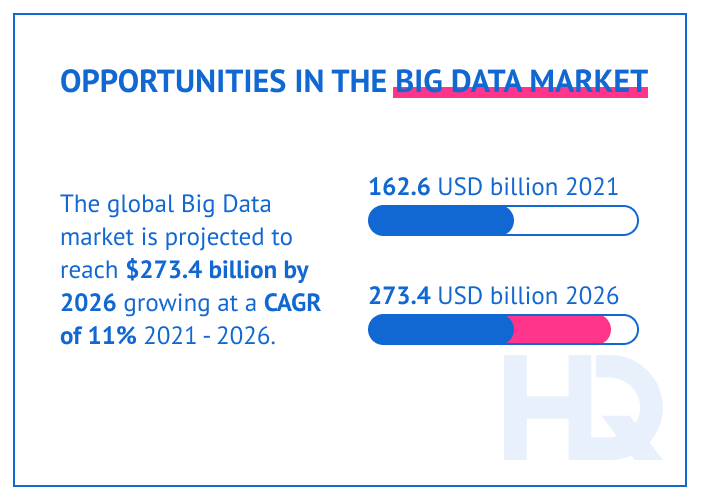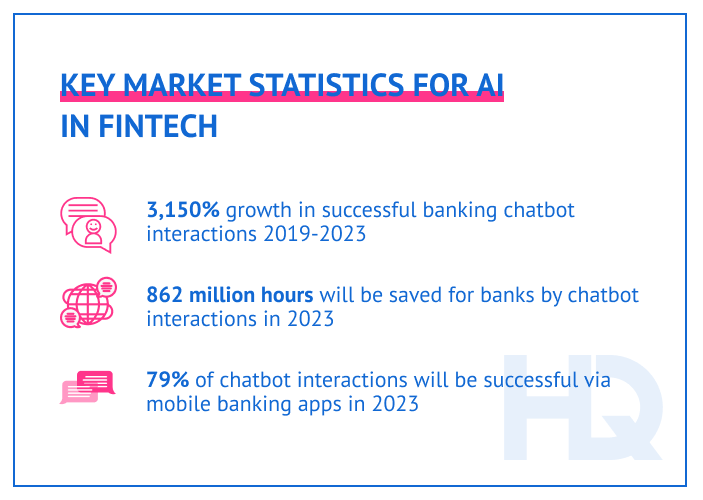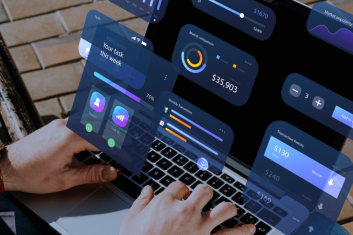According to Statista, as of November 2021, there were 10,755 fintech startups in the Americas and 9,323 in Europe, the Middle East, and Africa. Competition is tough, and to enter the market and not only survive but thrive, companies need to keep a sharp eye on current fintech trends.
Today, the share of bank executives who believe fintech is having a large impact on wallets and mobile payments globally amounts to 66.7%. If you want to know what current financial trends are having a big impact on app success right now, keep reading.
Factors That Will Shape Fintech Industry Trends in 2022
We’ve defined 10 trends that are shaping the future of fintech in 2022. Experience shows that financial companies that aren’t employing any of these will have a slim chance of surviving in the competition.
Digital banking
To gain clients and reduce maintenance costs, brick-and-mortar banks are embracing current technological opportunities and offering digitized banking with services provided online. Such banks enjoy substantial advantages, not only for the financial institution but also for their customers.
Customers don’t need to visit a bank branch to open an account or even sign documents. They can conduct transactions through secured digital channels while being assured that the bank is taking care of data security, regulatory aspects, and related risk mitigation.
Digital banking, one of the top trends in fintech, offers integration of online and mobile banking services with leading digital technologies such as innovative payment solutions, in-depth analytics, social media, and mobile technology.
Neobanks
Neobanks are fintech companies that offer a wide range of digital and mobile financial solutions, such as checking and savings accounts, money transfers, loans, and budget support.
While similar to digital banks, which are an online addition to traditional banks, neobanks have no branches and no specific physical location. All operations of neobanks are conducted online.
Like digital banks, neobanks offer advantages such as the convenience of banking from the comforts of home, 24/7 availability of access to banking functions, and the ability to set up automatic payments for regular utility bills.
The market size of neobanks was estimated at nearly $47 billion in 2021 and is projected to reach $2.05 trillion in 2030. That’s why we include them in our banking technology trends list.

Growing market size isn’t the only reason neobanks have become one of the major 2022 fintech trends. They provide flexibility that traditional banks don’t have:
- Having no physical presence allows such banks to offer their customers lower fees and higher interest rates on checking and savings accounts.
- Neobanks are easy to access and use. Setting up an account takes minutes.
- They operate 24/7 and their services can be accessed anywhere in the world, at any time.
Open Banking
Open banking, another finance industry trend, creates a smoother user experience. The term refers to enabling third-party payment services and financial services providers to access transactions, payment history, and other consumer banking information through the use of APIs. This technology promotes faster interoperability and networking between banking information and service providers.
What are the major advantages of this latest banking technology trend?
- Fewer barriers. Before open banking, there was little room for small to medium-sized businesses to enter the financial sector. Today, new players have access to the same data as big banks, allowing them to innovate and provide affordable alternatives to traditional financial services.
- Full consumer control. Open banking makes the banking experience interactive, as it advises people on their financial wellbeing. Consumers are in control of their finances — they not only have more choice about their financial provider but also decide how much data they want to share.
- Increased customer engagement. Open banking provides personalized services and improves the relevance of services suggested. This increases opportunities for customer engagement.
Big Data
According to Markets and Markets, the Big Data market size is projected to grow to $273.4 billion in 2026, at a CAGR of 11.0% during the forecast period. Big Data is so intensively employed that it is one of the hottest trends in fintech in 2022.

In the financial world, Big Data refers to the petabytes of structured and unstructured data used by banks and financial organizations to predict consumer behavior and develop strategies.
The financial sector has always generated large volumes of data. Unstructured data is accumulated from a variety of sources and has analytical potential. Structured data yields crucial decision-making insights.
Data science in fintech is used to forecast client behavior and generate sophisticated risk evaluations, make better judgments, and provide more personalized consumer experiences. This is what sets emerging fintechs apart from traditional financial institutions that are slow to digest the latest trends in banking technology.
AI-based solutions
Companies in the financial sector may leverage AI for a variety of purposes:
- Lending decision-making
- Credit risk assessment
- Customer support
- Insurance
- Fraud detection
- Wealth management.
Look at the numbers by Juniper Research, demonstrating the success of chatbots:
- a 3,150% increase in successful banking chatbot interactions between 2019 and 2023
- 826 million hours will be saved by banks in 2023
- 79% of successful chatbot interactions will be through mobile banking apps in 2023.
All this is achieved thanks to Artificial Intelligence.

Let’s examine the main benefits fintech companies can gain from this financial technology trend.
- Increased security. Experts claim that passwords and usernames will eventually be replaced by AI-backed security solutions, including speech recognition, facial recognition, etc. Biometric data adds a supplementary security layer and is more difficult to bypass than traditional passwords.
- Improved customer service. There are several ways AI can make customers more satisfied with their financial services and lessen the burden on staff. For example, chatbots can be used to minimize the workload placed on call centers as they tackle the most typical and frequent user problems. AI-powered personal banking apps can offer personalized financial advice to help users achieve their financial goals.
- User behavior analysis. AI can predict a user’s behavior with the help of AI APIs. This minimizes the number of requests and the load on the financial institution’s system.
Cybersecurity
This IBM research report demonstrates that over the past three years, financial services providers have been among the entities most frequently targeted by criminals. That’s why, out of all fintech app trends, cybersecurity is of crucial importance.
Proactive cybersecurity services, such as penetration testing, allow fintech companies to identify and patch vulnerabilities promptly and decrease the risk of fraud. The benefits of cybersecurity make it more than just another trend in fintech. It’s a necessity to build trust with customers. Attention to cybersecurity is vital from three perspectives:
- Compliance. Financial service providers face far more stringent regulatory requirements than other industries. For instance, PCI DSS requires financial institutions to implement an intrusion detection system to prevent breaches from going undetected or spreading.
- Fintech data protection. Many compliance frameworks and laws focus on data protection, for example, PCI DSS and the Gramm-Leach-Bliley Act. While these security standards bring increased protection against consumer data breaches, they also require fintech businesses handling this type of data to invest considerable resources into cyber security.
- Reputation. This is a top priority for all financial institutions, and there is nothing like a successful cyberattack to jeopardize a brand’s reputation. A core component of maintaining an excellent reputation is the security of customers’ data and money.
Currently, priority areas to work on in cybersecurity include:
- Transaction security — transaction intelligence risk control and secure identity authentication.
- Secure data management, including personal data protection.
- Security of service and innovative security technical tools.
Innovations in payment
The advent of service providers like PayPal, Square, Venmo, and Alipay has rewritten customer expectations around sending and receiving money, making this an enduring financial services technology trend. Customers now take for granted the ability to pay and get paid anywhere and at any time.
The more eagerly a company or institution welcomes innovations in payment, the more people will flock to its services. Major features that will lead the payment sector in 2022 are buy now, pay later, or BNPL; apps; mobile wallets; IoT; and biometrics.
- BNPL financing. This allows consumers to spread out payments over a defined period of time. BNPL transactions are projected to reach $995 billion by 2026, according to Juniper Research. Once BNPL providers establish a relationship with consumers, they’ll broaden their financial services range, offering loans, brokerage accounts, or crypto.
- Mobile wallets bulge with services. According to Gr4vy CEO John Lunn, 2022 will be the year when mobile wallets “rise to prominence”. The shift will be driven by merchants gradually moving away from card “swipe” fees and younger consumers experimenting with alternatives.
- IoT. Internet-connected devices, appliances, and wearables can now offer secure, fast, and easy payment solutions. However, as new devices come online, hackers get billions of potential vulnerabilities. That’s why companies will need to find new ways to guarantee the security and seamlessness of payments.
- Biometrics. Advanced technologies and the presence of no less advanced cybercriminals require consumers to rely on more than just a simple password to protect their accounts, assets, and other aspects of their digital presence. Biometrics provides an additional security layer with an eye scan or a well-placed hand.
Innovative fintech solutions development and enhancementHQSoftware has a team of skilled professionals ready to build, enhance, Let’s talk!
Julia Tuskal
Head of Sales
at HQSoftware
Blockchain
Markets and Markets estimates that the fintech blockchain market size will grow from $230.0 million in 2017 to $ 6,228.2 million by 2023, at a CAGR of 75.9% during the forecast period.
This is one technology trend in financial services that can not only reduce bank infrastructure costs by 30%, but also revolutionize the fintech domain by:
- Creating a digital ledger. In a ledger, you have pages chronologically recording and time-stamping transactions. A blockchain can digitally log the entire life cycle of money when it flows and changes hands. This is important in the banking industry, where it is essential to have an accurate record of transactions. Automated recording and time-stamping reduce the amount of time needed to record ledgers and the costs of recording them manually.
- Protecting against fraud. The decentralized nature of blockchain means no one has control over the chain. It can’t be altered. If fraud does occur, you can trace it back to a specific transaction and a specific person.
- Removing third parties from transactions. With blockchain, you can bypass traditional fraud prevention methods that require multiple parties to validate transactions. The advantage of a decentralized network is that transactions on a blockchain are automatically validated as they are sent to all the nodes in the network for authentication.
- Democratizing money management. You can hold your money without a bank in your personal digital wallet. Wallet-holders have a public address allowing them to receive payments from others and a private key, which is needed to send and spend their crypto. Those who have the keys are the only owners of the coins.
Decentralized Finance, or DeFi
One of the latest fintech ideas, which is closely connected to blockchain, is decentralized finance. Although at the moment it belongs to alternative financial tools and is associated with the crypto market, the future may lie in decentralization.
DeFi involves a range of financial solutions that operate without a single central authority — exchanges, lending, payment applications, etc. DeFi is managed through self-executing smart contracts. This means any Internet user can interact with the DeFi ecosystem and has no entry barriers to using financial services.
WealthTech
WealthTech refers to the use of technology to deliver better financial management solutions for building wealth. New digital services for managing personal and corporate finances have appeared, with robo-advisors and digital brokerage platforms becoming some of the most popular WealthTech services.
- Robo-advisors are automated platforms that use machine learning algorithms to help investors make important financial decisions. For example, they can provide recommendations based on market data and the user’s personal financial goals.
- Digital brokerage platforms provide easier access to information about the stock market, platforms that allow you to regularly invest small amounts of money without commission, and others.
The Bottom Line
Introducing the latest trends in fintech into your corporate activities is a marathon, not a sprint. Several questions should be answered before applying the latest trends to your applications. Will these new services replace existing architecture or be offered in parallel? Does this trend actually improve the existing product, or are we just adding complexity no one is really seeking? What kind of architectural or process changes are required?
It can be a daunting task to juggle the pros and cons of introducing new features. That’s where you need professional help. Based on our in-depth experience with finance software development services, we can answer your questions and advise you on the best way to stay current with fintech trends. Reach out!

Technology Researcher
Professional researcher at HQSoftware. Interested in solutions for retail, entertainment, and software that makes people's lives better.
Frequently Asked Questions
How to find out what fintech application is suitable for your needs?
What do developers need to begin creating a financial application?
What are the stages of banking application development?
We are open to seeing your business needs and determining the best solution. Complete this form, and receive a free personalized proposal from your dedicated manager.

Sergei Vardomatski
Founder






